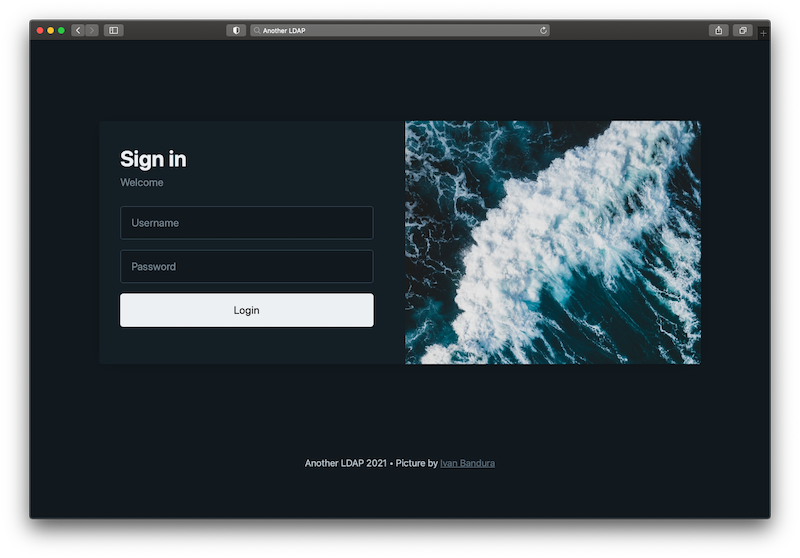Another LDAP is a form-based authentication for Active Directory / LDAP server.
Another LDAP provides Authentication and Authorization for your applications running on Kubernetes.
Another LDAP works perfect with NGINX ingress controller via (External OAUTH Authentication), HAProxy (haproxy-auth-request) or any webserver/reverse proxy with authorization based on the result of a subrequest.
- Authentication and Authorization for applications.
- Authorization via LDAP groups, supports regex in groups list.
- Supports protocols
ldap://andldaps://. - Enabled by design TLS via self-signed certificate.
- Supports configuration via headers or via environment variables.
- HTTP response headers with username and matched groups for the backend.
- Brute force protection.
- Log format in Plain-Text or JSON.
- Clone this repository or download the manifests from the directory
kubernetes. - Edit the ingress, config-map and secrets with your configuration.
- ALDAP is installed in the namespace
another.
git clone https://github.com/dignajar/another-ldap.git
cd another-ldap/kubernetes
kubectl apply -f .
The following example provides authentication for the application my-app.
- The authentication validates username and password.
---
kind: Ingress
apiVersion: networking.k8s.io/v1
metadata:
name: my-app
annotations:
kubernetes.io/ingress.class: "nginx"
nginx.ingress.kubernetes.io/auth-url: https://another-ldap.another.svc.cluster.local/auth
nginx.ingress.kubernetes.io/server-snippet: |
error_page 401 = @login;
location @login {
return 302 https://another-ldap.testmyldap.com/?protocol=$pass_access_scheme&callback=$host;
}
spec:
rules:
- host: my-app.testmyldap.com
http:
paths:
- path: /
pathType: Prefix
backend:
service:
name: my-app
port:
number: 80
The following example provides authentication and authorization for the application my-app.
- The authentication validates username and password.
- The authorization validates if the user has the LDAP group
DevOps production environment.
---
kind: Ingress
apiVersion: networking.k8s.io/v1
metadata:
name: my-app
annotations:
kubernetes.io/ingress.class: "nginx"
nginx.ingress.kubernetes.io/auth-url: https://another-ldap.another.svc.cluster.local/auth
nginx.ingress.kubernetes.io/auth-snippet: |
proxy_set_header Ldap-Allowed-Groups "DevOps production environment";
nginx.ingress.kubernetes.io/server-snippet: |
error_page 401 = @login;
location @login {
return 302 https://another-ldap.testmyldap.com/?protocol=$pass_access_scheme&callback=$host;
}
spec:
rules:
- host: my-app.testmyldap.com
http:
paths:
- path: /
pathType: Prefix
backend:
service:
name: my-app
port:
number: 80
The following example provides authentication and authorization for the application my-app and calls the application with the headers x-username and x-groups.
- The authentication validates username and password.
- The authorization validates if the user has one of the following LDAP groups
DevOps production environmentorDevOps QA environment. - Nginx will return the header
x-usernameto the application that contains the username authenticated. - Nginx will return the header
x-groupsto the application that contains the matched groups for the username authenticated.
With the headers you can do increase the authorization in the application or display the user logged.
---
kind: Ingress
apiVersion: networking.k8s.io/v1
metadata:
name: my-app
annotations:
kubernetes.io/ingress.class: "nginx"
nginx.ingress.kubernetes.io/auth-url: https://another-ldap.another.svc.cluster.local/auth
nginx.ingress.kubernetes.io/auth-response-headers: "x-username, x-groups"
nginx.ingress.kubernetes.io/auth-snippet: |
proxy_set_header Ldap-Allowed-Groups "DevOps production environment, DevOps QA environment";
nginx.ingress.kubernetes.io/server-snippet: |
error_page 401 = @login;
location @login {
return 302 https://another-ldap.testmyldap.com/?protocol=$pass_access_scheme&callback=$host;
}
spec:
rules:
- host: my-app.testmyldap.com
http:
paths:
- path: /
pathType: Prefix
backend:
service:
name: my-app
port:
number: 80
All parameters are defined in the config-map and secret manifests.
All values type are string.
The parameter LDAP_SEARCH_FILTER supports variable expansion with the username, you can do something like this (sAMAccountName={username}) and {username} is going to be replaced by the username typed in the login form.
The parameter LDAP_BIND_DN supports variable expansion with the username, you can do something like this {username}@TESTMYLDAP.com or UID={username},OU=PEOPLE,DC=TESTMYLDAP,DC=COM and {username} is going to be replaced by the username typed in the login form.
The parameter COOKIE_DOMAIN define the scope of the cookie, for example if you need to authentication/authorizate the domain testmyldap.com you should set the wildcard .testmyldap.com (notice the dot at the beginning).
The variables send via HTTP headers take precedence over environment variables.
Ldap-Allowed-UsersLdap-Allowed-GroupsLdap-Conditional-Groups: Default="or"Ldap-Conditional-Users-Groups: Default="or"
x-usernameContains the authenticated usernamex-groupsContains the user's matches groups




